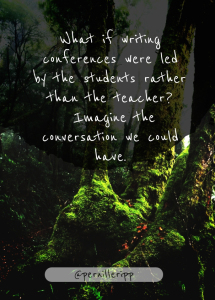OK, I’m having thoughts. Especially after reading Dan Meyer’s blog post about feedback vs. grades. When I dream about a perfect math class, what I’m really after is engagement. Not just “fun” engagement (although that too), but also true intellectual engagement with mathematics. I want more dialogue, intuition, and justification. Less right/wrong or can/can’t. I’ve been working in a PrBL (problem-based learning) program, and that’s one way to get there, but it’s not the goal itself. *gasp*
This year my partner teacher and I had a basic structure that we liked a lot:
- Group problem; sometimes funneled everyone to the same solution, sometimes not
- Individual problem based on the group problem; usually led to unique solutions for each student, e.g. gathering their own data or adapting the driving question to fit their own scenario
- Skill practice to reinforce what they learned in the problems
It was like the I-do-we-do-you-do model as far as scaffolding, but more student-centered. Still, everyone was on the same 1-2-3 path. There wasn’t enough flexibility for early finishers or students who needed more time for productive struggle.
Some kids need a confidence boost; others need a challenge. Some kids need lots of tasks to keep them busy; others need time to think deeply. Some kids need to fill holes in their basic skills while also engaging in higher order thinking at grade level.
What if students could self-differentiate? What if we offered a variety of tasks?
- Real world problem solving (engaging but not the only way to engage)
- Puzzle solving (problem-based but less real world)
- Pattern seeking (making connections and building intuition)
- Making/building artifacts or models (applying what they’re learning)
- Skill practice and workshops (direct instruction and review)
- Reflection (metacognition, extension, making connections, reaching out to teach others)
We wouldn’t have all of those for every math skill, but wouldn’t it be awesome to have more than one path for students to choose? I don’t know how to make that happen right away, but I know it sounds like a classroom I’d like to spend time in.
What would be some first steps for moving in this direction? What are some ways we could keep it manageable? What are some ways we could make sure everyone’s being productive?
My first instinct was a “one from column A, one from column B” approach, but I don’t think it really matters how many tasks they complete. What’s important is how much they learn from what they’re doing. I can imagine a student rushing through a skill practice worksheet and then getting totally into making a video or a board game to teach others the skill. They would be spending most of their time doing reflection, but would that be bad? Because like, as teachers we could point out that their audience might be more interested if they explained applications of the skill, and now they’re learning that too. And maybe even bringing in a partner who had chosen the real-world-problem-solving option and was now an expert on that.
This is probably just quarantine-induced delirium, but isn’t that where all the best thinking starts? 😉

